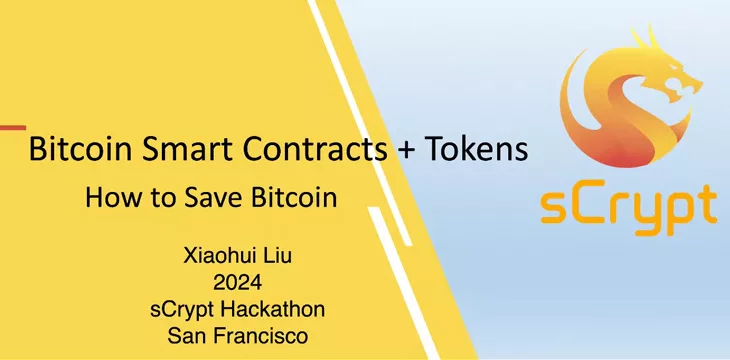|
Getting your Trinity Audio player ready...
|
Blockchain “can be anything you want” if you feel like experimenting, said sCrypt co-founder Xiaohui Liu at the opening presentation of the sCrypt Hackathon 2024 event last week. The Hackathon is an online competition for developers running from March 25 to April 25, 2024. Liu opened a two-day kickoff in San Francisco with a presentation titled “Bitcoin Smart Contracts & Tokens – How to Save Bitcoin.”
The morning session of Day One is available at this link, and you can catch the entire two-day series of sCrypt Hackathon 2024 presentations on the CoinGeek YouTube channel. The presentations tackle blockchain’s basic features before going into more technical detail about how sCrypt’s TypeScript-based environment makes it easier for developers to turn their visions into working products.
“We’re here for the tech. You guys here are the real Bitcoiners, I would say,” Xiaohui Liu began.
Buy why is Bitcoin in need of “saving,” as the presentation’s subtitle suggests? The answer is, despite 15 years of development, there still aren’t that many people who “use Bitcoin” (relatively speaking). There’s still “no mainstream killer app, as far as I can tell,” he added, or at least Bitcoin isn’t as prominent as many of the internet’s other big names.
‘This technology is gonna take us somewhere, but we don’t know where it is’
The problem is that when a new technology comes along, it still takes years of tinkering and experimenting before people understand what they’re supposed to do with it. Xiaohui Liu described today’s Bitcoin world as sitting in one or two camps: the older “boomers” exploring how Bitcoin and blockchain can improve the existing corporate/monetary systems, and the younger “degens” seeking entirely new digital economy paradigms on “Web3.” The camps could also be described as enterprise-tier vs. everyday/grassroots users. However, Xiaohui Liu said these two need not be mutually exclusive. sCrypt supports both.
The Bitcoin network is the “base layer” for this new technology, and sCrypt provides the “platform layer,” sitting between the base layer and the final apps people will use. Developers need to know the technology’s capabilities and be skilled at finding new ways to leverage these layers to build products that will finally capture everyone else’s attention.
The Bitcoin base layer and sCrypt’s platform layer provide these capabilities for developers to play around with micropayments, smart contracts, tokens, timestamping, and data immutability. Now, it’s up to the devs to find compelling use cases for these, just as the first smartphone app developers leveraged touchscreens, GPS, gyros/accelerators, and cameras. It wouldn’t have been adequate simply to port old desktop apps to the new platform, and initially, smartphone apps didn’t utilize all the hardware features available.
There are still many lessons to learn, and builders will need to test, release, and iterate their visions before discovering that ultimate killer app, Xiaohui Liu said. He described a virtuous cycle of more apps > more users > more developers > better dev infrastructure and tools that create a feedback loop and grow the blockchain ecosystem.
‘As long as you know JavaScript, you’re ready to go’
Smart contracts are unique to blockchain and a “key feature” for devs to use, Xiaohui Liu said. You can put any kind of logic you want into one. You can create transactions that execute with complex conditions, including time locks, voting, location awareness, and others. Best of all, sCrypt developers can use TypeScript (an extension of JavaScript) to write their code, meaning they won’t have to learn an entirely new language. You could also use Bitcoin’s native Script “if you’re really pro,” he added, though it’s much less user-friendly.
He described mailbox locks, cross-chain atomic swaps for assets, and even functions in the physical world like hotel keys and real estate transfers as some examples. With
tokenization, “you can tokenize anything,” he said, and any asset in the non-digital economy can be paired with a blockchain-based token, which can then be bought/sold, swapped, and traded.
As for how a token holder knows for sure their token represents a real-world asset (e.g., a bar of gold), Xiaohui Liu said the blockchain token would function similarly to the way physical keys or paper-based contracts do nowadays. For physical assets, there’d always be third parties involved, but smart contracts and tokenization make the transfer and record-keeping processes more efficient.
Interested developers can register here at the Hackathon website before March 25, 2024. The sCrypt’s website is open any time after that for people to find out more.
Watch: sCrypt wants to bring hackathon initiative to more people

 08-20-2025
08-20-2025 




